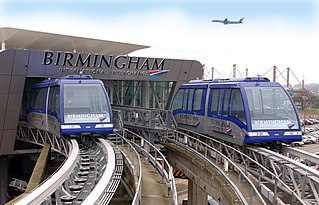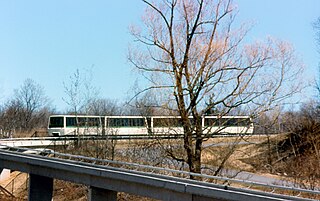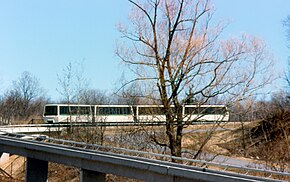
A monorail is a railway in which the track consists of a single rail or beam. Colloquially, the term "monorail" is often used to describe any form of elevated rail or people mover. More accurately, the term refers to the style of track. Monorail systems are most frequently implemented in large cities, airports, and theme parks.

A people mover or automated people mover (APM) is a type of small scale automated guideway transit system. The term is generally used only to describe systems serving relatively small areas such as airports, downtown districts or theme parks.

A rubber-tyred metro or rubber-tired metro is a form of rapid transit system that uses a mix of road and rail technology. The vehicles have wheels with rubber tires that run on a roll way inside guide bars for traction. Traditional, flanged steel wheels running on rail tracks provide guidance through switches and act as backup if tyres fail. Most rubber-tyred trains are purpose-built and designed for the system on which they operate. Guided buses are sometimes referred to as 'trams on tyres', and compared to rubber-tyred metros.

Transrapid is a German-developed high-speed monorail train using magnetic levitation. Planning for the system started in the late 1960s, with a test facility in Emsland, Germany inaugurated in 1983. In 1991, technical readiness for application was approved by the Deutsche Bundesbahn in cooperation with renowned universities.

An automated guideway transit (AGT) or automated fixed-guideway transit or automatic guideway transit system is a type of fixed guideway transit infrastructure with a riding or suspension track that supports and physically guides one or more driverless vehicles along its length. The vehicles are often rubber tired or steel wheeled, but other traction systems including air cushion, suspended monorail and maglev have been implemented. The guideway provides both physical support, like a road, as well as the guidance. An automated line can be cheaper to run than a conventional line, due to the shorter trains and stations.

Innovia Metro is an automated rapid transit system manufactured by Alstom. Innovia Metro systems run on conventional metal rails and pull power from a third rail but are powered by a linear induction motor that provides traction by using magnetic force to pull on a "fourth rail" placed between the running rails. However, newer versions of the technology are available with standard electric rotary propulsion.

Maglev is a system of rail transport whose rolling stock is levitated by electromagnets rather than rolled on wheels, eliminating rolling resistance.

The Terminal Link, formerly known as Link Train, is an automated people mover (APM) at Toronto Pearson International Airport in Mississauga, Ontario, Canada. The wheelchair-accessible train runs 24 hours a day, seven days a week and is completely free-of-charge to ride. In 2012, it transported 17,000 passengers daily, 60 to 70% of whom were airport staff.

The Crystal Mover is a rubber-tired automated people mover (APM) system for airport and urban rail transit applications manufactured at Mitsubishi Heavy Industries (MHI) Mihara Machinery Works in Mihara, Hiroshima Prefecture, Japan. The Crystal Mover, initially based on the Japanese APM standard, is used in automated guideway transit (AGT) systems in China, Japan, Singapore, South Korea, the United Arab Emirates and the United States.

The SCMaglev is a magnetic levitation (maglev) railway system developed by Central Japan Railway Company and the Railway Technical Research Institute.

The Cable Liner is a range of automated people mover products designed by Doppelmayr Cable Car for use at airports, in city centers, intermodal passenger transport connections, park and ride facilities, campuses, resorts and amusement parks.

The Air-Rail Link is a people mover linking Birmingham Airport with Birmingham International railway station and the National Exhibition Centre in England. The current system, originally known as SkyRail, replaced the earlier Birmingham Maglev system in 2003.
The ACT, acronym for Automatically Controlled Transportation or Activity Center Transit, was a people mover system developed during the 1970s. One feature of the ACT is that it allowed bi-directional travel on a single rail—cars passed each other by switching onto short bypass lanes on the track, distributed where space allowed. ACT was a contender in the Urban Mass Transportation Administration's plan to deploy three or four systems in cities in the United States, as well as the GO-Urban project in Toronto, Canada. One ACT system was installed as a part of a Ford-funded real estate development near their headquarters in Dearborn, MI, and although they proposed to install ACT in several other locations, no additional systems were ever installed and the project was put on indefinite hold.
ROMAG was a personal rapid transit (PRT) system produced by the American company Rohr, Inc. It featured a linear induction motor that was arranged to provide both traction and suspension in a magnetic levitation system.
Krauss-Maffei's Transurban was a 12-passenger automated guideway transit (AGT) mass transit system based on a maglev guideway. Development started in 1970 as one of the many AGT and PRT projects that followed in the wake of the HUD reports of 1968. Its selection as the basis of the GO-Urban system in Toronto in 1973 made it well known in the industry; it would have been the basis of the first large-area AGT mass transit network in the world. Technical problems cropped up during the construction of the test track, and the sudden removal of funding by the West German government led to the project's cancellation in late 1974. The Ontario government completed development and installation of a non-maglev version, today known as the Bombardier Advanced Rapid Transit.
GO-Urban was a planned mass transit project for Greater Toronto to be operated by GO Transit. The system envisioned the use of automated guideway transit vehicles set up in hydro corridors and other unused parcels of land to provide rapid transit services without the expense of constructing tunnels. GO-Urban would serve high-density areas in the downtown core, but also be able to accelerate to high speed between distant stations in the outskirts of the city. Similar deployments were planned for Hamilton and Ottawa.

The Dashaveyor was an automated guideway transit (AGT) system developed during the 1960s and '70s.

The University of the Philippines Diliman AGT was an automated guideway transit (AGT) system constructed for technology demonstration within the campus of the University of the Philippines (UP) in Diliman, Quezon City in the Philippines. It served as a test track for the first mass transit system to be built and developed in the country by local engineers.
Minitram was an automated guideway transit system studied by the Transport and Road Research Laboratory (TRRL), part of the UK Department of the Environment's Ministry of Transport. The system was based on small, completely automated tram-like vehicles of about 25 passengers that could be connected together into three-car trains to increase capacity. Proposed designs were submitted by Hawker Siddeley Dynamics (HSD) and EASAMS. HSD's system used rubber wheels and EASAMS' steerable steel ones, but the projects were otherwise similar and notably shared a linear motor for propulsion and most braking. A series of failed sales efforts in the UK and to the GO-Urban system in Toronto, combined with decreased government spending in the 1970s, led to the concept being abandoned.















